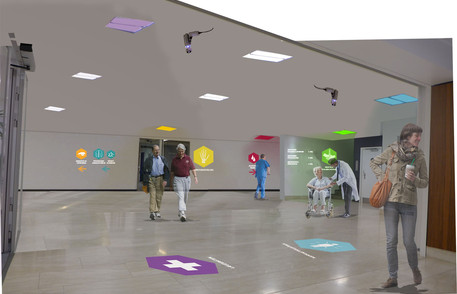FACTS
Assistance in selecting options for breast cancer follow-up care
Women with breast cancer face a difficult choice once their primary treatment is completed and they are declared healthy: Should they continue living as before – or should they accept preventative follow-up care? Radiation or medical treatment? Whichever they choose it will mean that they will constantly – maybe for ten years or more – be reminded that they have been ill. On the other hand, the chance of the cancer not recurring may be greater.
The staff at the Department of Oncology at Vejle Hospital has been in need of a tool that will make it easier for women to make that decision – and they asked Design School Kolding for help in developing a decision-making tool.
The assignment
The assignment is part of the collaboration between Design School Kolding and Lillebaelt Hospital, which is scheduled to end in the summer of 2015.
It is described as follows: The task is to gather knowledge about the processes currently guiding communication and decision making in order to transform that insight into a concrete design model that can be used in future communication and decision making processes. The study and the development of a design will include patients, relatives, doctors and nurses.
The purpose
The project is intended to improve the communication and the decision-making process when breast cancer patients have to make post-surgery decisions for or against continued treatment; it must also ensure a positive experience and adequate knowledge sharing/understanding of the disease and the treatment. The project is part of the scheme "Shared Decision Making" and is based on the desire for increased patient involvement.
The goal
The goal of the project is to develop a concrete decision-making tool for use in the Department of Oncology at Vejle Hospital in order to facilitate the hospital’s work with women who have recently been diagnosed with breast cancer and these women’s involvement/decision regarding post-operative treatment.
The project team
From Design School Kolding the project team consists of:
Laila Green Truelsen, Head of LAB for Social Inclusion. Laila has a degree in Communication Design; she is also trained as a public school teacher. For many years Laila has worked on how design methods can contribute to social change, e.g. in the project Design of Relationships, which won Local Government Denmark's Innovation Award 2013; in a project in Sædding/Ådalen in Esbjerg, which focusses on cooperation among different groups in a neighbourhood; in the project "Kitchen Stories," which highlights the difference between food and meals – and many others.
Joan Pedersen, product designer and trained as a public school teacher with 10 years’ experience in special education. Joan was part of the project team on Design of Relationships, and she has extensive experience in user surveys and the use of design methods and design processes in collaboration with external partners. She also participated in the above-mentioned project in Esbjerg and in "Kitchen Stories."
Denise Dyrvig Jørgensen: Interaction designer and service designer; she has experience with interaction design in projects for Kolding Municipality among others.
The management group
Must ensure the progress of the project and consists of representatives from the following three entities:
Sygehus Lillebælt:
Ann Mathilde Furrer Regner Birkelund Troels Bechmann
Design School Kolding:
Andrea Corradini / Kathrina Dankl Laila Grøn Truelsen Joan Petersen / Denise Jørgensen Syddansk Sundhedsinnovation (Healthcare Innovation of Southern Denmark):
Lise Wraae Silberling
The process
The process used in the project is based on Design School Kolding’s application of "The Five Cs" in the design process and includes the phases; Collaborate, Collect, Comprehend, Conceptualise and Create. See the model on the right.
The design phases – an iterative process
The above-mentioned model of the design phases illustrates that the process is not a linear model, in which the division of the phases (collect, comprehend, conceptualise and create) happens sequentially. Conversely the design process will most likely be iterative – i.e. it is necessary to return to the previous phases again and maybe a second time in order to modify the process. For example, you gain some exciting knowledge in the ‘collect’ phase; you analyse it in the ‘comprehend’ phase, and you develop concepts that are being tested – and during these tests you realise that you do not have enough knowledge, that the concept is not strong enough. You must therefore gather more knowledge and go back to the ‘collect’ phase. This is a common occurrence in a design process and it means that you constantly become more knowledgeable, not only about the situation here and now but also about what may emerge in the future.






